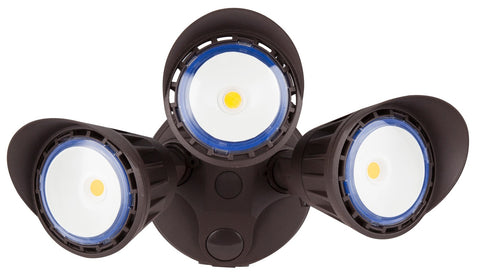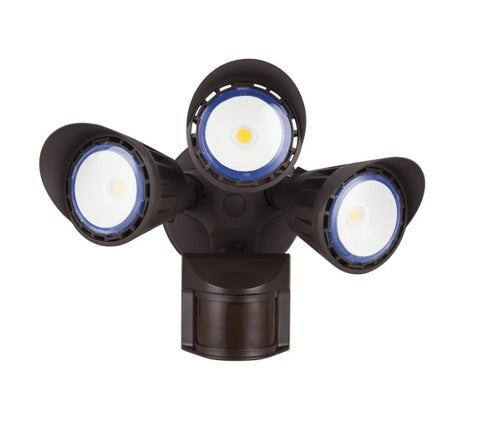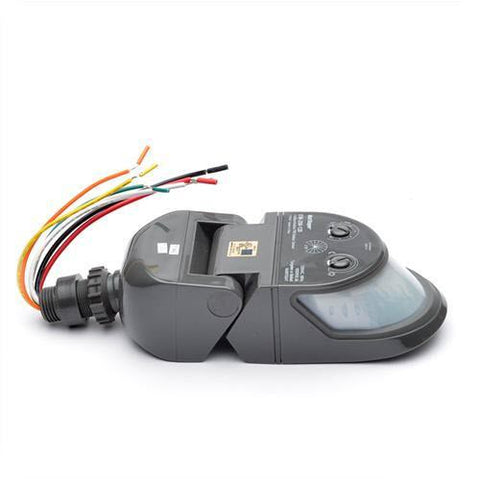What’s the difference between Energy Star and Design Lights Consortium approved lighting products?
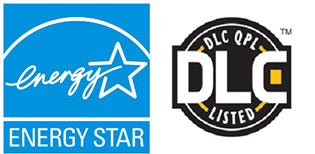
When searching for energy efficient lighting products, most buyers have probably noticed that some products display a blue Energy Star label while others display a Design Lights Consortium (DLC) label. This usually leads to them ask the following questions:
- What’s the difference between the two?
- Why are products labeled with one or the other, but not both?
- How does a given product become Energy Star or DLC approved?
In order to answer these questions, let’s first look at the backgrounds behind them.
Energy Star
Energy Star is a program started by the United States Environmental Protection Agency (EPA) in 1996 to help reduce air pollution. In 2005, the EPA and the Department of Energy (DOE) expanded it to include promotion of energy efficient products and buildings. This expansion of its mission was meant to help reduce energy consumption and lower all types of pollution. It is a voluntary program that not only applies to lighting products, but also to computers, household appliances, heating and cooling systems and home electronics, among other things.
The Energy Star label tells the consumer that the product has met efficiency standards set by the EPA and DOE.This means that products with it are safer for the environment than those without it. Although originally established the United States, the Energy Star program has become an international standard.
In order to earn the Energy Star label, products are independently tested by a third party EPA-certified laboratory before being sold on the market. These approved products are later tested at random to ensure that they still meet Energy Star standards. Some of the standards for lighting products are:
- Fluorescent lighting must use 75% less energy and last up to 10 times longer than incandescent lights
- LED lighting must use 75% less energy than incandescent lights
- LED lighting must last 35 to 50 times longer than incandescent lighting and about 2 to 5 times longer than fluorescent lighting. No bulb-replacements, no ladders, no ongoing disposal program.
Design Lights Consortium
The DLC is a regional group that focuses on energy efficiency specifically in the lighting industry. It is a part of the Northeast Energy Efficiency Partnerships (NEEP) and was originally focused on the Northeast and Mid-Atlantic areas of the United States. It was set up in 1998 in order to promote quality, performance and energy efficient commercial sector lighting solutionsin the building sector. The DLC set up a program called the “knowhow series” which instructed electrical contractors and lighting distributors on how to outfit commercial spaces with efficient lighting that was also attractive, functional, and up to code.
In 2010, the DLC created the Qualified Products List (QPL) of commercial grade LED lights, a leading resource that distinguishes quality, high efficiency LED products for the commercial sector. In 2012, due to the DLC’s success, programs from over thirty states and three Canadian provinces joined the DLC. Today, these groups collaborate to push the lighting market towards even more innovation and energy efficiency.
Products must meet strict requirements to make the QPL or to earn the DLC logo on their packaging. Manufacturers must apply and pay a fee to have a DLC-approved third party test their products.
Differences
- DLC is strictly for lighting products, whereas Energy Star is applied to many other types of products.
- Energy Star is typically used for consumer products, DLC is used for commercial products.
- There are no products that have both ratings, only one or the other. There is no overlap between the two. For example, recessed lighting is within the jurisdiction of Energy Star; therefore, DLC does not rate this type of product.
- Energy Star can claim jurisdiction over particular products, so if this happens to a DLC product, DLC must remove its label.
- Energy Star covers CFL light bulbs, LED light bulbs, residential luminaires, decorative light strings and ceiling fans with light kits.
- DLC covers commercial products not covered under Energy Star such as roadway lights or parking garage lights.
Depending on location, some ES and DLC lights are eligible for tax rebates and incentives. Either way, both labels tell the buyer that the products that display them have met strict efficiency standards.
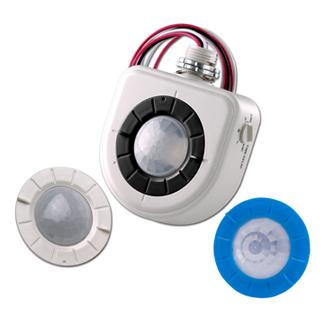
Occupancy Sensors and Accessories for High Bay Lighting
At Warehouse Lighting, we are dedicated to providing you with the best high bay sensors for industrial lighting at Warehouse-Lighting.com. We have a variety of occupancy sensors designed to provide illumination in your space when you need it. Order your high bay occupancy sensors online at Warehouse-Lighting.com.
View (20) Products
Difference Between T5 and T8 Low Bay Fluorescent Lighting Fixtures
Finding the right lighting solution for your location means comparing your options. When choosing between two types of lighting, there are many factors you may want to consider. For your l...
Watch Video High Bay LED Lighting
High Bay LED Lighting
 Industrial Low Bay Lighting
Industrial Low Bay Lighting
 Industrial Strip Lights
Industrial Strip Lights
 Vapor Tight Lighting
Vapor Tight Lighting
 LED Shop Lights
LED Shop Lights
 Hazardous Area / Explosion Proof Lighting
Hazardous Area / Explosion Proof Lighting
 Loading Dock Lights
Loading Dock Lights
 Construction / Portable Lighting
Construction / Portable Lighting
 Industrial Ceiling Fans
Industrial Ceiling Fans
 LED Work Lights
LED Work Lights
 Networked Controlled Lighting
Networked Controlled Lighting
 NEW Warehouse Lighting Fixtures
NEW Warehouse Lighting Fixtures
 Clearance
Clearance
 Troffer Lights
Troffer Lights
 LED Flat Panel Lights
LED Flat Panel Lights
 Drop Ceiling Lights
Drop Ceiling Lights
 Suspended LED Lights
Suspended LED Lights
 LED Cylinder Lights
LED Cylinder Lights
 Exit / Emergency
Exit / Emergency
 Wrap Lighting Fixtures
Wrap Lighting Fixtures
 Gooseneck and Barn Lights
Gooseneck and Barn Lights
 Stairway & Corridor Lighting
Stairway & Corridor Lighting
 Hospital Bed Lights
Hospital Bed Lights
 Commercial Sign Lights
Commercial Sign Lights
 Recessed Lighting
Recessed Lighting
 Wafer Lighting
Wafer Lighting
 RGB LED Lights
RGB LED Lights
 Grow Lights
Grow Lights
 UV Disinfecting Lights & Air Purifier Fixtures
UV Disinfecting Lights & Air Purifier Fixtures
 Refrigeration Lighting
Refrigeration Lighting
 LED Flood Lights
LED Flood Lights
 Outdoor Wall Lights
Outdoor Wall Lights
 LED Area Lights
LED Area Lights
 Parking Lot Lights & Poles
Parking Lot Lights & Poles
 Outdoor Post Top Lights
Outdoor Post Top Lights
 LED Stadium Lighting
LED Stadium Lighting
 Canopy Lights
Canopy Lights
 Security & Motion Sensor Lights
Security & Motion Sensor Lights
 LED Bollard Lights
LED Bollard Lights
 Outdoor LED Linear Light Fixtures
Outdoor LED Linear Light Fixtures
 Solar Powered LED Lighting
Solar Powered LED Lighting
 Dusk to Dawn Lights
Dusk to Dawn Lights
 Landscape Lighting
Landscape Lighting
 Outdoor String Lights
Outdoor String Lights
 Coastal Wildlife Lighting
Coastal Wildlife Lighting
 Outdoor House Lights
Outdoor House Lights
 Architectural Linear Lights
Architectural Linear Lights
 Architectural Grid Mount Lights
Architectural Grid Mount Lights
 Architectural Round Pendant Lights
Architectural Round Pendant Lights
 Architectural Square Linear Lights
Architectural Square Linear Lights
 Architectural X-Shaped Linear Lights
Architectural X-Shaped Linear Lights
 Architectural LED Wall Packs
Architectural LED Wall Packs
 Ceiling Fans
Ceiling Fans
 Ceiling Lights
Ceiling Lights
 Chandelier Lights
Chandelier Lights
 Pendant Lighting
Pendant Lighting
 Island Lights
Island Lights
 Track Lighting
Track Lighting
 Under Cabinet Lighting
Under Cabinet Lighting
 Vanity Lights
Vanity Lights
 Wall Sconces
Wall Sconces
 LED Tape Lights
LED Tape Lights
 LED Mirrors
LED Mirrors
 LED Light Bulbs
LED Light Bulbs
 LED Tube Lights
LED Tube Lights
 LED Corn Lights
LED Corn Lights
 Vintage LED Bulbs
Vintage LED Bulbs
 Decorative LED Bulbs
Decorative LED Bulbs
 Fluorescent Light Bulbs
Fluorescent Light Bulbs
 Metal Halide Lamps
Metal Halide Lamps
 LED Magnetic Strip Retrofit Kits
LED Magnetic Strip Retrofit Kits
 LED Strip Light Retrofit Kits
LED Strip Light Retrofit Kits
 High Bay LED Retrofit Kits
High Bay LED Retrofit Kits
 LED Troffer Retrofit Kits
LED Troffer Retrofit Kits
 LED Wall Pack Retrofit
LED Wall Pack Retrofit
 LED Street Light Retrofit Kits
LED Street Light Retrofit Kits
 Recessed Lighting LED Retrofit Kits
Recessed Lighting LED Retrofit Kits
 Ballasts & Drivers
Ballasts & Drivers
 Emergency Ballast For LED & Fluorescent Lights
Emergency Ballast For LED & Fluorescent Lights
 Electrical Supplies & Mounting Kits
Electrical Supplies & Mounting Kits
 Electrical Tools
Electrical Tools
 Switches & Receptacles
Switches & Receptacles
 Electrical Power Cords
Electrical Power Cords
 Sensors and Timers
Sensors and Timers
 Smart Home Automation
Smart Home Automation
 High Bay Occupancy Sensors
High Bay Occupancy Sensors
 Electric Vehicle Chargers
Electric Vehicle Chargers
 Hand Dryers
Hand Dryers
 LED Shop Lights
LED Shop Lights
 Garage LED Light Fixtures
Garage LED Light Fixtures
 Office Lights
Office Lights
 Classroom Lights
Classroom Lights
 Church Lights
Church Lights
 Gym Lighting
Gym Lighting
 Factory Lights
Factory Lights
 Hospital Lights
Hospital Lights
 Walkway Lights
Walkway Lights
 Parking Lot Lights
Parking Lot Lights
 Exterior Building Lights
Exterior Building Lights
 Sports Lighting
Sports Lighting
 Airport Lights
Airport Lights
 NSF Rated Lights
NSF Rated Lights
 Restaurant Lights
Restaurant Lights
 Corridor Lights
Corridor Lights
 Barn Lighting
Barn Lighting






